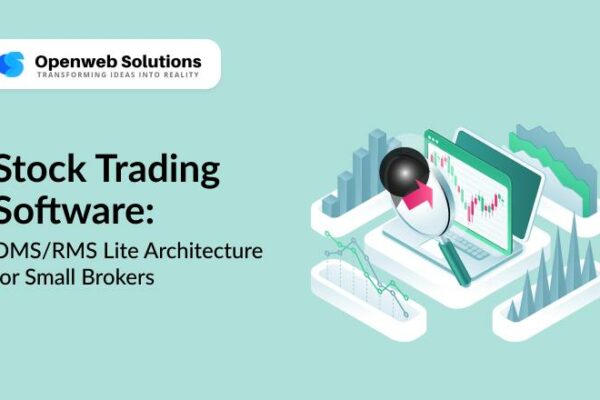In today’s digital economy, reaching traders across devices is no longer a luxury — it’s a necessity. Whether users trade on iOS, Android, or web platforms, seamless functionality is vital. This calls for a cross-platform stock market app development strategy that delivers consistent, real-time trading experiences without platform limitations.
📱 Why Cross-Platform Development is Essential in Stock Market Software Development
Targeting a broader user base means accommodating users on different devices — from smartphones to tablets and desktops. Opting for cross-platform app development reduces development overhead by maintaining a single codebase, slashing both time-to-market and ongoing maintenance costs. It allows businesses to:
-
Maximize reach without developing separate native apps
-
Ensure uniform UX across all devices
-
Reduce development and testing cycles
-
Increase market entry speed
This approach is now a standard practice in stock market software development, as trading platforms must be secure, responsive, and accessible to all.
🧩 Core Strategies for Effective Cross-Platform Stock Market App Development
1. Choose the Right Development Framework
Selecting the right cross-platform framework is critical. Some top choices include:
-
React Native: Offers near-native performance with reusable components.
-
Flutter: Google-backed UI toolkit with beautiful UI widgets.
-
Xamarin: Ideal for enterprise-grade apps with access to native APIs.
These frameworks empower teams to build high-performing apps while reducing code duplication — a core principle of effective stock market app development.
2. Enable Real-Time Data Streaming with Stock Market App Development
Trading apps must deliver live stock prices and market data. This requires:
-
WebSockets for low-latency data transfer
-
Push notifications for immediate price alerts
-
Financial APIs (e.g., Alpha Vantage, Yahoo Finance, NSE/BSE feeds)
Real-time streaming is non-negotiable for user trust and trading accuracy.
3. Ensure Cross-Device Performance Optimization in Stock Market App Development
Whether it’s a 6-inch mobile or a widescreen monitor, performance consistency is key. Cross-platform tools help optimize:
-
UI responsiveness across resolutions
-
Memory management to prevent crashes
-
Graphics rendering for technical charts and dashboards
Using Flutter’s Skia engine or React Native’s bridge model ensures smooth UI/UX transitions and better performance tuning.
4. Implement Strong Security & Regulatory Compliance
Trust and security are cornerstones of any stock market software development project. Recommended practices:
-
Multi-Factor Authentication (MFA)
-
Biometric login (fingerprint, face unlock)
-
End-to-End Encryption
-
Regulatory Compliance with SEBI, GDPR, and FINRA standards
A secure, unified codebase simplifies applying these protocols across platforms.
5. Craft a Responsive, Data-Driven UI/UX
User experience influences retention and transaction frequency. Key features should include:
-
Intuitive portfolio dashboards
-
Live charting tools
-
Seamless transaction flows
-
Adaptive layouts for mobile and desktop
Great UI/UX design builds user trust — an often underrated yet powerful ranking signal per Google’s Helpful Content System.
6. Leverage Cloud Integration
Storing data in the cloud allows users to:
-
Access accounts on multiple devices
-
Synchronize watchlists and transaction history in real time
-
Receive updates and notifications without delay
Cloud infrastructure also simplifies app updates, ensuring lower downtime and faster rollouts.
🌍 Can Cross-Platform App Development Boost Reach?
Absolutely.
With growing demand for online and mobile trading, a cross-platform approach delivers a unified experience across OS platforms. Businesses involved in stock market website development can extend their presence beyond just web — into a full-stack ecosystem including mobile apps, APIs, and integrated dashboards.
🧠 Final Thoughts
Cross-platform development is no longer just a cost-saving approach — it’s a growth strategy for any fintech or stock trading business. From faster deployments to unified security and excellent user engagement, it provides everything a modern trader expects.
📈 Looking to dominate the trading app market? Partner with a stock market app development company with proven expertise in scalable, secure, and responsive cross-platform apps.
📚 FAQs: Cross-Platform Development for Stock Trading Apps
Q1. Why choose cross-platform app development for trading platforms?
Ans: It ensures wider reach, cost efficiency, faster go-to-market, and unified experience across iOS, Android, and web — essential for trader engagement.
Q2. Which frameworks are ideal for stock market apps?
Ans: React Native, Flutter, and Xamarin offer flexibility, native-like performance, and fast cross-platform deployment — all vital for stock market app development.
Q3. How do I integrate real-time data feeds?
Ans: Use WebSockets or push notifications along with trusted APIs (like Alpha Vantage or NSE India) to enable low-latency, real-time data streaming.
Q4. What security features should be implemented?
Ans: Multi-factor authentication, biometric login, SSL encryption, and compliance with GDPR/FINRA/SEBI norms are mandatory for trading platforms.
Q5. What role does cloud play in stock market app development?
Ans: Cloud hosting ensures seamless access across devices, efficient data syncing, faster app updates, and reduced operational downtime.
Partha Ghosh is the Digital Marketing Strategist and Team Lead at PiTangent Analytics and Technology Solutions. He partners with product and sales to grow organic demand and brand trust. A 3X Salesforce certified Marketing Cloud Administrator and Pardot Specialist, Partha is an automation expert who turns strategy into simple repeatable programs. His focus areas include thought leadership, team management, branding, project management, and data-driven marketing. For strategic discussions on go-to-market, automation at scale, and organic growth, connect with Partha on LinkedIn.






